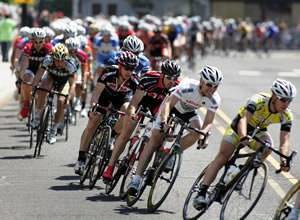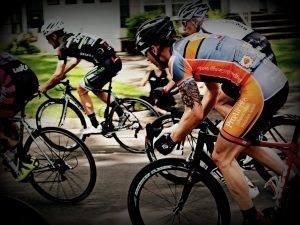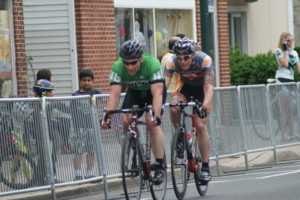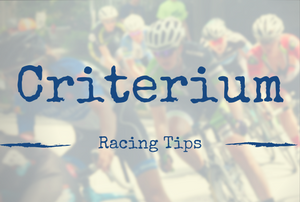Call it a criterium, a crit, or a short circuit race. Whatever you call it, it's a tough race for sure. It's also one of the most common races on most racing calendars. What makes it so tough to succeed at and what training do you need to perform well in these races?
In this episode of the Tailwind Coaching Podcast, I'll tell you how to build the perfect criterium training plan. I'll show you what specific training needs to be included in your crit training plan to help you crush the field and hit the line first. There are also a few tips, tricks and secrets to help you make the most out of your training and races.
So if you're ready to tune up your crit fitness, click through the jump and listen for tips on dominating your next criterium.
Podcast: Play in new window | Download (Duration: 59:08 — 45.1MB)
Subscribe: RSS
 What is a criterium?
What is a criterium?
A criterium (or “crit” for short) is a short circuit race. Riders compete over a short circuit of around a mile and ride for a set number of laps or a certain amount of time. Generally, crit races last anywhere from 45 minutes to an hour, longer for more advanced racers. The whole race will feature a peloton of riders, from 15 to 75 strong.
Crits are fast paced, exciting races that reward patience, tactical acumen, and strong physical endurance. If succeeding in criterium races is one of your goals, you'll need to focus on a few specific training goals.
So what kind of fitness do you need to do well in a crit? Well, you have to be fatigue resistant, you need to be explosive and you need to be able to repeat that explosive effort. I'll tell you what you need to add to your crit training plan to make that happen.
What's in a criterium training plan?
A criterium training plan is not just a case of adding some VO2 max work to your weekly riding. There's a little more to consider if you want to be a successful crit racer. You'll need plenty of endurance, plenty of VO2 max capacity and a ton of repeatability.
Get more muscular endurance to stay fresher
Make no mistake, muscular endurance is the cornerstone of my training programs. I've talked about it plenty of times in the past. It's no different for criterium racing either.
Muscular endurance is the key to resisting the fatigue that can set in over a long crit race. The more times you ask a muscle to forcefully contract, the more some of those fibers will fatigue. Once some of the fibers are exhausted, they can no longer contract efficiently. Your body will have to recruit additional fibers to do the same amount of work, leading to an increase in metabolic wastes and lactic acid buildup. Additionally, as you fatigue more and more of those fibers, eventually they begin to contract strongly without relaxing. This leads to the dreaded cramping we're all familiar with.
Performing muscular endurance intervals help create fatigue resistance in your muscle fibers. By putting your muscles under constant tension, especially at a high workload, you can train them to resist failure and cramping. In a criterium training plan, you'll want to add multiple muscular endurance intervals per week. These should start around 20 minutes in length and the total “time under tension” for each session should be AT LEAST the length of an average crit in your category. So if your races are around 45 minutes in length, aim to do a couple sessions per week, each one totaling 45 minutes or more. Aim for a lower cadence, 65-75 RPM and keep your intensity somewhere between sweetspot and threshold.
Raise your VO2 max capacity
Raising your VO2 max is a necessary part of raising your functional threshold power. It's also a necessary intensity to train for criterium racing.
Criteriums work like this: you go over your threshold to close a gap, sprint out of a corner or move up through the field. Then you soft pedal and recover. Then you do it again. By raising your VO2 max capacity and the power you can produce at VO2 max levels, you'll be able to handle those “red zone” moments better. For example, if you do fine at 110% of threshold but you can't handle 120% of threshold, you're going to get popped.
On top of that, you need to work through endurance at those intensities. If you can do 3 minutes at 120% of functional threshold power (the upper end of your VO2 max intensity) that's great. If you can do it 10 times in a race, that's awesome! Guess who is going to be better off during that race? Yep, it's the guy who has endurance at VO2 max.
In order to train VO2 max endurance, you'll need repeated intervals above functional threshold power. Adding interval repeats such as 8 minutes at 110% of FTP, 5 minutes at 115% of FTP and 3 minutes at 120% of FTP are great ways to build VO2 max endurance.
 Build explosive power
Build explosive power
Criteriums are fast races with a lot of explosive efforts. You may have to sprint out of a corner 40 or 50 times during a typical criterium race. That doesn't count the accelerations you'll need to move up through the field or catch breakaways and attacks.
If you want to be able to handle those hard efforts, you need to train your body to put out big power on demand. That means you'll need to train zone 6 and zone 7 efforts and be able to create power on demand. That means a lot of force production in a short amount of time. It also means you'll need some level of endurance at those really high intensities if you want to hang with the peloton.
To complete your crit training, you'll need to add Zone 6 and 7 intervals to your program. For zone 7, work on explosive power, add track start repeats (sprinting in a huge gear from a nearly standing start) and track sprints (sprinting in a huge gear from higher speed.) You can add 3-5 efforts during each high-intensity day you have in your criterium training program, up to twice per week. Those will help you build the explosive acceleration necessary to close gaps and latch onto breakaways.
Once you can lay down the power to close a gap or accelerate out of the bunch you need to be able to hold onto that effort for a little while to make it count. That's where Zone 6/7 endurance work comes into play. Add 1-minute intervals at 150% of functional threshold power and 2-minute intervals at 130% of functional threshold power to be able to maintain that power output long enough to make a difference.
Now that you can apply power to the pedals, you have to think about being efficient during your accelerations. That's where your neuromuscular training comes into play.
Increase neuromuscular efficiency
Along with muscular endurance, neuromuscular efficiency is one of the keys to building lasting criterium fitness. You have to be able to turn the pedals efficiently if you want to have enough energy left to actually race in the closing minutes of a crit.
Neuromuscular intervals make you a lot more efficient. Neuromuscular intervals also help you cope with changes in pace without having to shift or stand. With good cadence control, it's easy to close gaps by ramping up your cadence or applying a little extra force.
To add neuromuscular work to your crit training program, add some single leg drills and superspin intervals to your program. You can add these during all kinds of riding, especially in between other kinds of intervals. Superspins are especially effective when you're going downhill. The increased speed simulates the conditions of a fast peloton and lets you practice that really high cadence.
In order to learn how to effectively change cadences, add some singlespeed work into your training program. These workouts are a variety of sweetspot training or functional threshold workouts. Pick a stretch of road that has some rolling terrain and stay in a single gear. You will learn how to moderate your cadence, but you will get some over/under work. By sticking to one gear, you'll have to add power to get over rises and back down to recover on the other side. If you plan well, the result will be 20 minutes of sweetspot or threshold work, some over/unders and some cadence work.
Improve repeatability and the ability to recover
Because crits are full of short, sharp accelerations, you need to train your repeatability too. Each one of those accelerations is a match burned. Recovery between those efforts is important to light up another match. Where most cyclists run into difficulty is training the recovery between those efforts.
Adding a few specific intervals to your training can boost your anaerobic repeatability. Tabata type intervals are a good start. By working 20 seconds on at max effort and 10 seconds off at easy spinning, you'll train both anaerobic capacity and recovery. Start at 5 minutes and bump up towards 10. Additional over/under intervals or zone 5 repeats can help build fatigue resistance. The idea of these repeats are to work just above threshold (for example 110%) and recovery just below threshold (around sweetspot.) Work and rest intervals should be about the same length. If you increase the intensity to 120%, cut the work duration or decrease the intensity of the recovery.
Racing a criterium effectively
Racing a crit is as much an exercise in patience as it is in fitness. You'll have to burn matches in order to succeed in a criterium, but when and how you choose to burn those matches takes some learning. If you want to be successful, you have to follow a couple of simple rules:
- Stay near the front! You want to keep yourself around the top 15% of the field. This is the safest place around, lets you keep tabs on what's happening in the peloton. You're in the best position to launch or counter attacks and avoid
 the “accordion effect” that plagues the rear of a peloton.
the “accordion effect” that plagues the rear of a peloton. - Don't sit in the wind. Unless team strategy dictates, you're not going to do the pulling. Most lower category crit racers are solo or racing with just one other person. If you're not pulling for a teammate, you should be sitting in. Wait for the moment that appeals to your strengths and make your move when you're good and fresh. Pulling the field along guarantees you'll be tired when it comes time to throw down.
- Have a plan A, B, C, D… “Even the best laid plans of mice and men” is a phrase that applies here. Have a plan A. Then have a plan B if that fails. And a plan C if that fails. Even have a plan D, E, F, etc in order to cover eventualities. If you're racing as a team, this may mean multiple options for multiple racers. When racing solo, different winning strategies should be based on your strengths and weaknesses.
- If racing solo, research your competition, see who's successful in these kinds of races and keep them close. Guys who win or consistently place highly are worthy of following their wheel.
- Breaks and covering moves is an art. The best time to attack is when an attack is caught and the field takes the pressure off. If you're thinking of going with a break, know who is going on the break and be ready to go with a potential winning move. If you know that move won't stick, don't waste energy.
- Know your sprint distance. You'll have plenty of training data to go through, so there's no excuse for not knowing how far you can sprint from. If, based on your training, you can maintain a long sprint, go from a long way out. With a blistering acceleration, you'll hold your sprint until you're very close to the line. If you can't sprint but you have amazing 5-minute power, you'll have the best chance of winning by taking a last lap flyer.
Marginal gains for criterium racing and training
- Weight doesn't matter! While I've talked about watts per kilogram in the past, it doesn't really apply during crits. The more raw power you can put out the better, regardless of size. The only time this may come into play is during a crit that has some elevation changes. Although, strong guys can still power over those pretty easily.
- If you're a serious crit racer, a skinsuit will give you some aero benefit and an [easyazon_link identifier=”B00N2B1RWY” locale=”US” tag=”taicoaandthed-20″]aero helmet[/easyazon_link] will give you an extra few percentage points.
- You need to get comfortable in the drops. You have the best control, it's the safest place to ride from because protects the hooks of your bars from others. For an example of how this can be an issue, take a look at how I was crashed in 2015. The guy who crashed me wasn't protecting his hooks.
- Ride the corners smart. Focus on the corner and the exit out of it, not on the wheel in front of you. They may do something completely stupid that you don't want to follow. Don't be a jerk and dive bomb the corner or cut across someone else's wheel though.
- Position yourself smart: Stay in the top 15% of the field. Never sit in the wind if you can avoid it. Don't be afraid to pull for 10-20 seconds at a time, but don't sit on the front and drive unless you have a teammate to set up.
- Pre-riding is a must to determine the 100m, 150m, 200m, etc marks. Use a stationary landmark so you don't have to think, just see the landmark and launch your move. Preride to figure out where you can attack, make a breakaway attempt or launch your sprint, depending on your strengths.
Now that you've got all the tools you need to build a crit training program and race effectively, get out there and toe that line!
